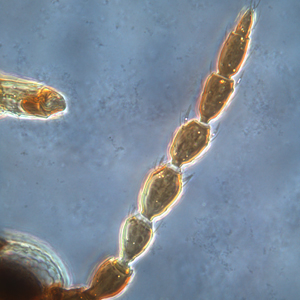Figures
Fig. 1: Antenna
Fig. 2: Head dorsal with maxillary stylets and maxillary bridge
Fig. 3: Pronotum
Fig. 4: Prosternal sclerite plates
Fig. 5: Meso- and metanotum
Fig. 6: Fore- and hindwing
Fig. 7: Tergites IV and V with 2 pairs of sigmoid wing retaining setae
Fig. 8: Tergite X
ITS-RFLP gel patterns (1&8 ladder, 2 PCR-product, 3 RSAI, 4 HaeIII, 5 MspI, 6 HinfI, 7 AluI)
Fig. 9: Primer pair CS249/CSS250
Fig. 10: Primer pair O1/18J
Fig. 11: Primer pair P1/28Z
Fig. 12: Primer pair 18SMP/28SMP
Taxonomic Information
Species:
Haplothrips aculeatus (Fabricius, 1803)
Synonyms:
Haplothrips crassicornis Priesner,
1928
Haplothrips funebris Priesner, 1928
Haplothrips cephalotes Bagnall, 1913
Anthothrips minor Karny, 1907
Phloeothrips japonicus Matsumura, 1899
Phloeothrips oryzae Matsumura, 1899
Thrips frumentarius Beling, 1872
Phloeothrips albipennis Burmeister, 1836
Thrips aculeatus Fabricius, 1803
Common name:
Cereal thrips
Present taxonomic position:
Family: Phlaeothripidae Uzel, 1895
Subfamily: Phlaeothripinae (Uzel) Priesner, 1928
Genus: Haplothrips Amyot & Serville, 1843
Species Recognition
General information about the genus Haplothrips:Most of the 200 species within this genus are macropterous and have duplicated fringe cilia on the forewing, with the forewing constricted medially and contain well developed paired prosternal basantra. The species in this group which contain single fringed cilia on the forewing belong to the subgenus Trybomiella. In addition, Haplothrips species have four sense cones on antennal segment IV, the head contains a well developed maxillary bridge, complete epimeral sutures on the pronotum, a triangular shaped pelta, and abdominal tergites II through VII exhibit two wing retaining setae.
Typical character states of Haplothrips aculeatus:
Body color
Mainly brown
Antennae
Number of antennal segments: 8
Segment III - number of sense cones: 1
Segment IV - number of sense cones: 3
Segments III & IV sensoria: emergent and simple
Head:
Basal thirds of cheeks: without a pair of stout setae
Maxillary stylet position: about one third of head width apart
Postocular setae: about half to nine tenths as long
as
Maxillary bridge: present
Cheeks: without one pair of stout setae in basal third
Prothorax
Number of pairs of elongate pronotal setae: 1-4
Pronotum: with faint sculpture
Prosternal basantra: present
Metathorax
Metanotum structure: weakly rerticulate
Wings
Wings: present and more than half as long as abdomen
Forewing shape: constricted medially
Forewings: surface smooth, without veins, setae and microtrichia
Legs
Fore femur: without a strong, cylindrical tooth near the base
Abdomen:
Abdominal segment X: complete tube in both sexes
Abdominal tergites: with curved wing-retaining setae
Biology
Life history:
This genus contains about 200 species which all live in flowers particularly composite flowers, rushes and sedges. Most of these species are found in the tropics of Europe, and Asia and their life cycle from egg to adult is not well known however, most life stages are found in the flowers mentioned above.
Host plants:
Cereals
Vector capacity:
None identified
Current known distribution:
None identified
Additional notes:
This species is considered a pest in
Eastern Europe.
Bibliography
Bhatti, JS (2006): The Classification
of Terebrantia (Insecta) into Families. Oriental Insects 40: 339-375.
Cott, E. H. (1956): Systematics of the suborder Tubulifera
(Thysanoptera) in California. University of California Publications in
Entomology, Vol. 13, ppg. 1-216.
Lewis, T (1997): Pest thrips in perspective, pp. 1-13.
In Lewis, T [ed.] Thrips as Crop
Pests. Wallingford, UK: CABI. 740 pp.
Moritz G, Morris DC, Mound LA (2001): ThripsID -
Pest thrips of the world. ACIAR
and CSIRO Publishing Collingwood, Victoria, Australia, CDROM ISBN
1 86320 296 X.
Moritz G, Mound LA, Morris DC, Goldarazena A (2004): Pest
thrips of the world - an identification and information system using molecular
and microscopial methods. CBIT, University of Queensland,CDROM ISBN 1-86499-781-8.
Mound, LA & Kibby, G (1998): Thysanoptera: An identification
guide, (2nd edition). CAB International, Wallingford and New York,
70pp.
Mound, LA & Marullo, R (1996): The
thrips of Central and South America: An Introduction (Insecta: Thysanoptera).
Associated Publishers, Gainesville.
Nickle, DA (2003): A checklist of commonly intercepted thrips
(Thysanoptera) from Europe, the Mediterranean, and Africa at U.S. ports-of-entry
(1983-1999). Part 1. Key to genera. Proceedings of the Entomological Society
of Washington 105: 80-99.
Nickle, DA (2004): Commonly intercepted thrips (Thysanoptera)
from Europe, the Mediterranean, and Africa at U.S. ports-of-entry. Part II. Frankliniella Karny
and Iridothrips Priesner (Thripidae). Proceedings of the Entomological
Society of Washington 106: 438-452.
Palmer, JM, Mound, LA & Du Heaume, GJ (1989): 2. Thysanoptera,
pp. 73. In Betts, CR [ed.], CIE Guides
to Insects of Important to Man. CAB International, Wallingford.
Steigen, AL & Klekowski,
RZ (1978): Oxygen-consumption in 2 Species of Thysanoptera, Haplothrips
aculeatus Fabr and Taeniothrips simplex (Mor). - Ekologia
Polska-Polish Journal of Ecology 26 (4): 573-582.
Links:
Mound, LA (2005): Thysanoptera (Thrips) of the World
- A Checklist. http://www.ento.csiro.au/thysanoptera/worldthrips.html













